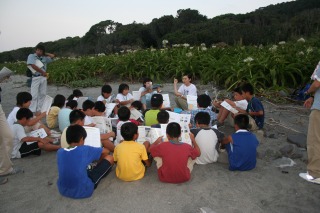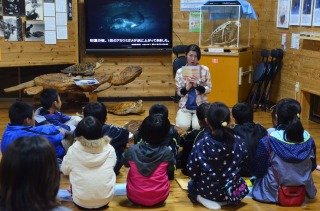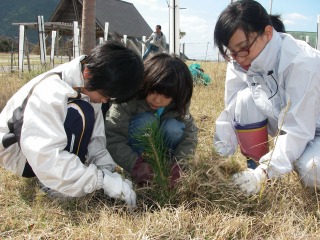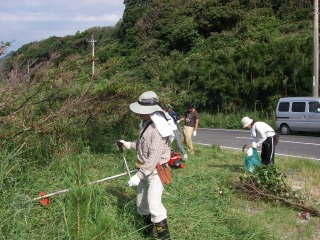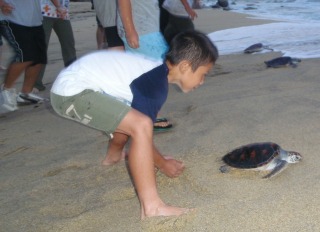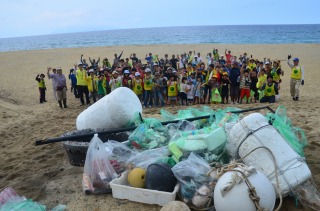| HOME |
| Activity |
*** Activity ***

|
'The Research Group for Yakushima Sea Turtles,' the precursor of the non-profit
organization (“NPO”) Yakushima Umigame-kan, was founded in April 1985 in
Nagata, the north-western part of Yakushima, to protect the most beautiful
beaches of Yakushima.
During this time, the sand from the beach was excavated to be used as building materials. The excavation continued despite the fact that the sand had decreased to almost half to a quarter of what was there in the 1960s.
The main idea of the NPO is to preserve the beaches where the turtles come to lay eggs by generating jobs related to sea turtles through the following activities:
|
▼ Ecological investigation of sea turtles

|
We aim to help protect the turtles by conducting research on the behavior
of the sea turtles which is still unknown.
Yakushima is the largest nesting area for loggerhead turtles in the Northern
Pacific Region, attracting about 50% of all loggerhead turtles that come
to lay eggs in Japan; thus, the research and monitoring in Yakushima is
expected to gather much attention worldwide.
|
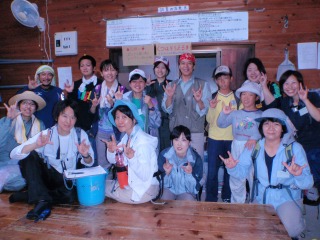 |
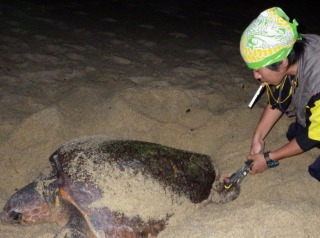 |
Before departing for ecological investigation
|
Attachment of tag
|
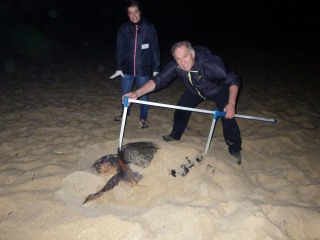 |
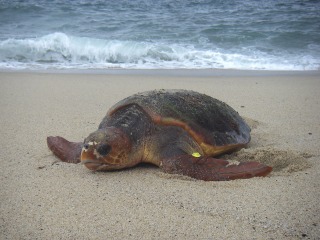 |
Measurement of shell size
|
Loggerhead turtle with tag attached
|
Individual identification is important. We attach the Multi-flex P tags to left front and left rear flippers and inject the internal PIT tags into left front flipper. We also measure the size and record characteristics of carapace, and measure body weight if possible. Tags are necessary for understanding things such as the number of times sea turtles lay eggs, the migration route, years it takes for sea turtles to return to the beach, lifespan, and so on. Research by tags revealed that, in Yakushima, most loggerhead turtles lay eggs three times on average per one nesting season although it was once recorded that one individual laid eggs as many as six times. Research by tags also revealed that sea turtles come back to Yakushima every two to three years and that most loggerhead turtles migrate around the East China Sea. There were two loggerhead turtles that migrated as far as Philippines, one of which was found in the Nagata-hama of Yakushima following year.
|
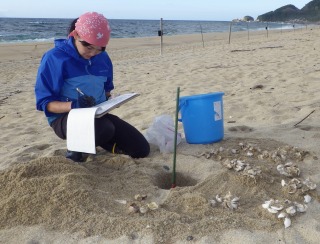 |
Research on hatching
|
| We research hatching by excavating the nest approximately 3 to10 days after
the hatchlings emerge from the nest. We monitor the number of hatched and
unhatched eggs to calculate the success rate for hatching. Hatching rate
and emerging rate vary depending on the seasonal change of the given year.
Dead hatchlings as well as eggs eaten by maggot, ghost crab, beetle larva,
white ant and so on are often observed. Recently, the number of dead hatchings
and embryos stepped by visitors has been increasing, resulting in the higher
hatching and emerging rates at places without visitors than those with
visitors. In general, the hatching and emerging rates are higher after
mid-August. |
|
▼ Conservation of sea turtles

|
Researching the behavior of sea turtles can accompany the rescue of sea
turtles, the support for laying eggs, or the relocation of eggs. Since
sea turtles generally live in the ocean and only return to the beach for
nesting, they are not used to life on the land. In some cases, they may
get stuck in wave-dissipating blocks or rocks, or fall from sea wall. We
rescue such turtles, assist sea turtles with deformed or disabled flipper
in laying eggs, and relocate eggs which may be washed away by typhoon and
high tides to the safer place. Although these activities are helpful in
increasing the number of sea turtles, protecting the habitat is the most
important for sea turtles to become self-sustaining.
|
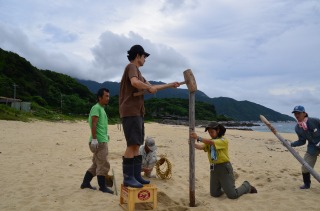 |
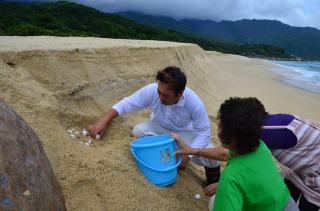 |
|
Setting up a fence to protect the nests
from trampling
|
Protecting the eggs before being washed away
|
 |
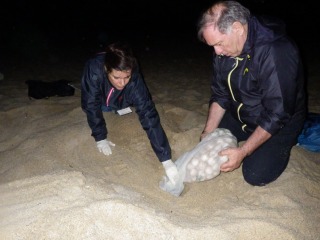 |
Protecting the eggs before being tramped on
|
Relocating the rescued eggs
|
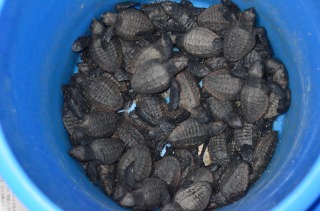 |
|
Protecting the baby turtles before dying from trampling
|
Sea turtles decide the nesting place considering the geography of beach
or artificial factors. If sea turtles lay eggs in areas which can be affected
by typhoons, high tides, or visitors, eggs are relocated to safer places
such as the upper section of the beach and the area surrounded by the protection
rope installed during the nesting/hatching season. Relocating eggs with
embryo requires caution because embryo dies when placed upside down; to
avoid this, we mark the top of the eggs before relocation. The most important
thing, however, is to preserve the beach where eggs can hatch without relocation.
|
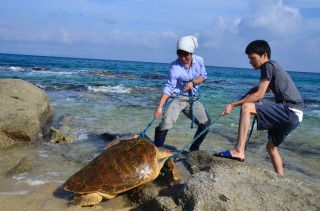 |
Rescuing a turtle stuck in a rock
|
Sea turtles that landed on the beach move around to find a suitable place
for nesting. In some cases, they may get stuck in wave-dissipating blocks
or rocks; in other cases, they may fall from breakwater. Sea turtles exposed
to less moist environment may dehydrate due to sun light or get fever,
which eventually causes death. Therefore, it is necessary to rescue these
turtles as promptly as possible. However, rescuing sea turtles that weight
almost 100 kg is not easy and requires a lot of manpower.
|
|
▼ Protection and enlightenment of the environment
 |
|
|

Copyright (C) 2017 Yakushima Umigame-kan,NPO. All rights reserved |
|
|











